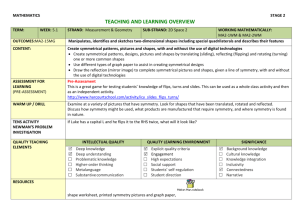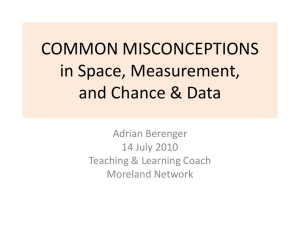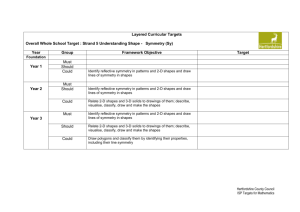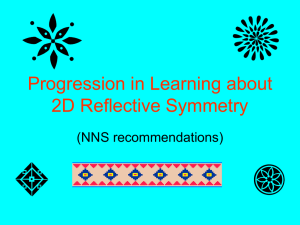Road Safety Year 5 Week 1 Plan
advertisement
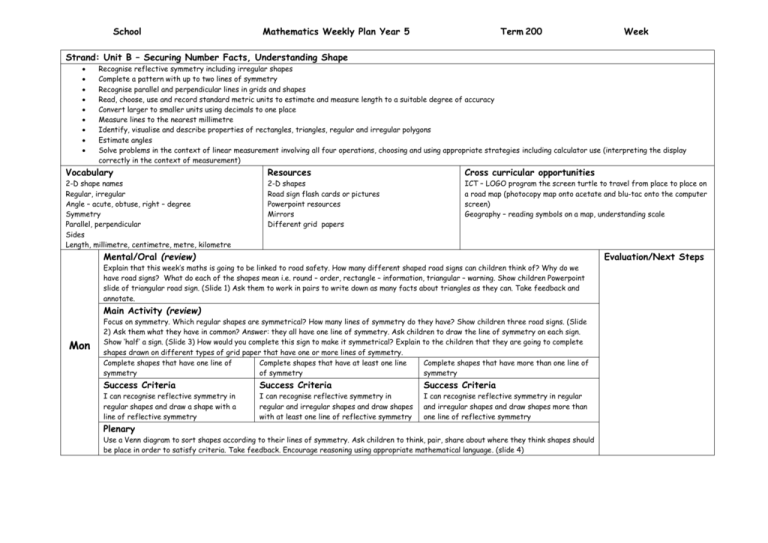
School Mathematics Weekly Plan Year 5 Term 200 Week Strand: Unit B – Securing Number Facts, Understanding Shape Recognise reflective symmetry including irregular shapes Complete a pattern with up to two lines of symmetry Recognise parallel and perpendicular lines in grids and shapes Read, choose, use and record standard metric units to estimate and measure length to a suitable degree of accuracy Convert larger to smaller units using decimals to one place Measure lines to the nearest millimetre Identify, visualise and describe properties of rectangles, triangles, regular and irregular polygons Estimate angles Solve problems in the context of linear measurement involving all four operations, choosing and using appropriate strategies including calculator use (interpreting the display correctly in the context of measurement) Vocabulary 2-D shape names Regular, irregular Angle – acute, obtuse, right – degree Symmetry Parallel, perpendicular Sides Length, millimetre, centimetre, metre, kilometre Resources 2-D shapes Road sign flash cards or pictures Powerpoint resources Mirrors Different grid papers Cross curricular opportunities ICT – LOGO program the screen turtle to travel from place to place on a road map (photocopy map onto acetate and blu-tac onto the computer screen) Geography – reading symbols on a map, understanding scale Mental/Oral (review) Explain that this week’s maths is going to be linked to road safety. How many different shaped road signs can children think of? Why do we have road signs? What do each of the shapes mean i.e. round – order, rectangle – information, triangular – warning. Show children Powerpoint slide of triangular road sign. (Slide 1) Ask them to work in pairs to write down as many facts about triangles as they can. Take feedback and annotate. Main Activity (review) Mon Focus on symmetry. Which regular shapes are symmetrical? How many lines of symmetry do they have? Show children three road signs. (Slide 2) Ask them what they have in common? Answer: they all have one line of symmetry. Ask children to draw the line of symmetry on each sign. Show ‘half’ a sign. (Slide 3) How would you complete this sign to make it symmetrical? Explain to the children that they are going to complete shapes drawn on different types of grid paper that have one or more lines of symmetry. Complete shapes that have one line of Complete shapes that have at least one line Complete shapes that have more than one line of symmetry of symmetry symmetry Success Criteria I can recognise reflective symmetry in regular shapes and draw a shape with a line of reflective symmetry Plenary Success Criteria I can recognise reflective symmetry in regular and irregular shapes and draw shapes with at least one line of reflective symmetry Success Criteria I can recognise reflective symmetry in regular and irregular shapes and draw shapes more than one line of reflective symmetry Use a Venn diagram to sort shapes according to their lines of symmetry. Ask children to think, pair, share about where they think shapes should be place in order to satisfy criteria. Take feedback. Encourage reasoning using appropriate mathematical language. (slide 4) Evaluation/Next Steps Mental/Oral (rehearse) Repeat activity from previous day with a different shape e.g. road sign for no through road – T shape is an irregular octagon. (Slide 5) In feedback focus on angles, perpendicular and parallel sides. Evaluation/Next Steps Main Activity (rehearse and teach) Tues Recap on previous day’s activity where children where expected to complete a shape with one or more lines of symmetry. Explain that today they are going to create their own road sign which must have at least one line of symmetry that would encourage road safety. Decide whether it is to be an information, order or warning sign. What symbols might they use that are symmetrical? Use different grid papers. Use squared paper to draw signs that have Use different grid papers to draw shapes with at Use different grid papers to draw shapes with more one line of symmetry (horizontal or vertical least one line of symmetry. Vary the position of than one line of symmetry. Vary the position of the mirror line) the mirror line e.g. horizontal, vertical, diagonal mirror line e.g. horizontal, vertical, diagonal Success Criteria I can draw shapes that has one line of symmetry on squared paper Success Criteria I can draw shapes that have at least one line of symmetry on different grid papers Success Criteria I can draw shapes that have more than one line of symmetry on different grid papers Plenary Use a Carroll diagram to sort shapes according to set criteria relating to angles. Ask children to think, pair, share about where they think shapes should be place in order to satisfy criteria. Take feedback. Encourage reasoning using appropriate mathematical language. (Slide 6) Mental/Oral (teach and rehearse) Revise units of linear measurement – millimetre, centimetre, metre and kilometre, their abbreviations and the relationship between them e.g. 10 mm = 1 cm. Answer simple questions using these facts e.g. how many millimetres are therein two centimetres?, how many centimetres in ½ a metre etc. Main Activity (teach and rehearse) Wed Show children road layout. (Slides 7-9) Explain that this is going to be part of a new road layout in a new town. Go through the key, asking to question to ensure they understand it. What does the arrow mean? (one way street) Why might this street be one way? (For the safety of the children at the school.) Explain that over the next few days they are going to decide upon street furniture for the new layout. Share with them the cards that say there must be street lighting at a certain distance. Look at the scale of the map. How are they going to work out where the street lamps should go? Model and demonstrate how to use the scale to do this. Give children a copy of Map A (scale 2cm = Give children a copy of Map B (scale 3cm = 300 m) Give children a copy of Map C (scale 3cm = 200 m) 100 m) and street lamp card A – street and street lamp card A – street lamps every 150 and street lamp card B – street lamps every 100 lamps every 100 m. Ask the children to use m. Ask the children to use a ruler and the scale to m. Ask the children to use a ruler and the scale to a ruler and the scale to put crosses on put crosses on either side of the roads to show put crosses on either side of the roads to show either side of the roads to show where where street lighting should go. where street lighting should go. street lighting should go. Success Criteria I can interpret a scale and use it to solve a problem. I can use a ruler to measure accurately in centimetres and record measurements using appropriate mathematical notation Plenary Success Criteria I can interpret a scale and use it to solve a problem. I can use a ruler to measure accurately in millimetres, convert these to centimetres and record using appropriate mathematical notation. Success Criteria I can interpret a scale and use it to solve a problem. I can measure accurately in millimetres, convert these to centimetres and record using appropriate mathematical notation Ask children to feedback on the number of street lamps they have positioned on particular roads. What difficulties did they encounter and how did they overcome these? Evaluation/Next Steps Mental/Oral Revise linear units of measurement and the relationships between them. Solve mentally, problems involving linear measurement and all four operations Evaluation/Next Steps Main Activity Thur Look again at the road layout map from the previous day. Introduce cards that give instructions as to where other street furniture is to be positioned. Think carefully why things are positioned where they are. Invite the children to work in pairs to discuss, reason and justify where the respective street furniture should be positioned. Children to use the SAME maps that they did the previous day. They should think of symbols to represent the different pieces of street furniture. They should name the roads and record how far down each road they position each piece e.g. telephone box 200m from junction of ….and … (Give children as many or as few street furniture cards as appropriate to their ability) Success Criteria I can measure accurately using a ruler to a suitable degree of accuracy and record measurements using appropriate abbreviations Success Criteria I can measure accurately using a ruler to a suitable degree of accuracy and record measurements using appropriate abbreviations. I can use a scale to convert between units of measurement. Success Criteria I can measure accurately using a ruler to a suitable degree of accuracy and record measurements using appropriate abbreviations. I can use a scale to convert between units of measurement Plenary Invite children to feedback on their choices asking them for reasoning and justification. Mental/Oral Revise linear units of measurement and the relationships between them. Solve mentally, problems involving linear measurement and all four operations Evaluation/Next Steps Main Activity Fri Look again at the planned road layout. Today the children are going to investigate routes. Archie lives in house A. He walks to school. What is his quickest route to school if he walks? What would be his quickest route if he cycled or went in a car? What is the difference between the two journeys? Extension: If Archie visited the bakers on his way home from school what would be the total distance of his journey walking? Cycling or going in a car? Success Criteria I can use a simple scale to convert units of measure. I can solve simple problems involving linear measurement. Success Criteria I can use a scale to convert units of measure. I can solve problems involving linear measurement. Success Criteria I can use a scale to convert units of measure. I can solve more complex problems involving linear measurement. Plenary Feedback possible solutions and strategies used to solve the problem. How did they tackle it? Did they encounter problems and adapt their way of working? How did they record their findings? Possible home learning: complete Friday’s activity OR calculate the distance of their journey to school.

